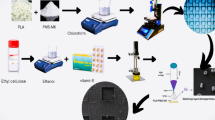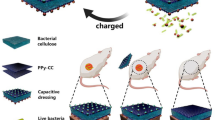Abstract
The formation of bacterial biofilms on the surface of implanted materials is a critical factor that may lead to chronic microbial infection and tissue necrosis. In the present study we analysed the stability of polyelectrolyte multilayer (ML) films on suture materials and the antibacterial effect obtained with chlorhexidine (CHX)-functionalized films built on different types of suture materials such as silk, polyester and copolymer of glycolide and l-lactide. The comparison of Escherichia coli culture on glass coverslips and glass coverslips with ML and CHX showed at 24 h an inhibition of the bacterial relative luminescence (40.68%, P < 0.5) and at 48 h (99.46%, P < 0.001). In another way, simple soaking of suture material overnight in CHX digluconate 20% without polyelectrolyte films did not at all protect sutures from bacterial colonization but CHX-functionalized polyelectrolyte films, made from poly-l-glutamic acid and poly-l-lysine, inhibited Escherichia coli proliferation.





Similar content being viewed by others
References
P.A. Marshall, G.I. Loeb, M.M. Cowan, M. Fletcher, Response of microbial adhesives and biofilm matrix polymers to chemical treatments as determined by interference reflection microscopy and light section microscopy. Appl. Environ. Microbiol. 55, 2827 (1989)
H.C. Jones, I.L. Roth W.M. Saunders III, Electron microscopic study of a slime layer. J. Bacteriol. 99, 316 (1969)
M.E. Rupp, G.L. Archer, Coagulase-negative staphylococci: pathogens associated with medical progress. Clin. Infect. Dis. 19, 231 (1994)
E. Barth, Q.M. Myrvik, W. Wagner, A.G. Gristina, In vitro and in vivo comparative colonization of Staphylococcus aureus and Staphylococcus epidermidis on orthopaedic implant materials. Biomaterials 10, 325 (1989). doi:10.1016/0142-9612(89)90073-2
G. Harkes, J. Feijen, J. Dankert, Adhesion of Escherichia coli on to a series of poly methacrylates differing in charge and hydrophobicity. Biomaterials 12, 853 (1991). doi:10.1016/0142-9612(91)90074-K
H. Akiyama, R. Torigoe, J. Arata, Interaction of Staphylococcus aureus cells and silk threads in vitro and in mouse skin. J. Dermatol. Sci. 6, 247 (1993). doi:10.1016/0923-1811(93)90046-R
J.C. Nickel, I. Ruseska, J.B. Wright, J.W. Costerton, Tobramycin resistance of Pseudomonas aeruginosa cells growing as a biofilm on urinary catheter material. Antimicrob. Agents. Chemother. 27, 619 (1985)
G.D. Christensen, W.A. Simpson, A.L. Bisno, E.H. Beachey, Adherence of slime-producing strains of Staphylococcus epidermidis to smooth surfaces. Infect. Immun. 37, 318 (1982)
J.W. Costerton, P.S. Stewart, E.P. Greenberg, Bacterial biofilms: a common cause of persistent infections. Science 284, 1318 (1999). doi:10.1126/science.284.5418.1318
P.S. Stewart, J.W. Costerton, Antibiotic resistance of bacteria in biofilms. Lancet 358, 135 (2001). doi:10.1016/S0140-6736(01)05321-1
K.A. Selvig, G.R. Biagiotti, K.N. Leknes, U.M. Wikesjö, Oral tissue reactions to suture materials. Int. J. Periodontics Restorative Dent. 18, 474 (1998)
L.H. Silverstein, G.M. Kurtzman, A review of dental suturing for optimal soft-tissue management. Compend. Contin. Educ. Dent. 26, 163 (2005)
K.N. Leknes, I.T. Roynstrand, K.A. Selvig, Human gingival tissue reactions to silk and expanded polytetrafluoroethylene sutures. J. Periodontol. 76, 34 (2005). doi:10.1902/jop.2005.76.1.34
M. Yaltirik, K. Dedeoglu, B. Bilgic, M. Koray, H. Ersev, H. Issever et al., Comparison of four different suture materials in soft tissues of rats. Oral Dis. 9, 284 (2003). doi:10.1034/j.1601-0825.2003.00954.x
J.L. Burns, B.W. Ramsey, A.L. Smith, Clinical manifestations and treatment of pulmonary infections in cystic fibrosis. Adv. Pediatr. Infect. Dis. 8, 53 (1993)
D. Stickler, J. Dolman, S. Rolfe, J. Chawla, Activity of antiseptics against Escherichia coli growing as biofilms on silicone surfaces. Eur. J. Clin. Microbiol. Infect. Dis. 8, 974 (1989). doi:10.1007/BF01967568
C.E. Edmiston, G.R. Seabrook, M.P. Goheen, C.J. Krepel, C.P. Johnson, B.D. Lewis et al., Bacterial adherence to surgical sutures: can antibacterial-coated sutures reduce the risk of microbial infection? J. Am. Coll. Surg. 203, 481 (2006). doi:10.1016/j.jamcollsurg.2006.06.026
A. Gomez-Alonzo, F.J. Garcia-Criado, F.C. Parreno-Manchado, J.E. Garcia-Sanchez, E. Garcia-Sanchez, A. Parreno-Manchado et al., Study of the efficacy of coated Vicryl Plus antibacterial suture (coated polyglactin 910 suture with triclosan) in two animal models of general surgery. J. Infect. 54, 82 (2007). doi:10.1016/j.jinf.2006.01.008
G. Decher, Fuzzy nanoassemblies: toward layered polymeric multicomposites. Science 29, 1232 (1997). doi:10.1126/science.277.5330.1232
X. Arys, P. Fischer, A.M. Jonas, A. Laschewsky, R. Legras, E. Wischerhoff, Ordered polyelectrolyte multilayers. Rules governing layering in organic binary multilayers. J. Am. Chem. Soc. 125, 1859–1865 (2003). doi:10.1021/ja0283807
P.T. Hammond, Recent explorations in electrostatic multilayer thin film assembly. Curr. Opin. Colloid Interface Sci. 4, 430 (1999). doi:10.1016/S1359-0294(00)00022-4
Y. Lvov, M. Onda, K. Ariga, T. Kunitake, Ultrathin films of charged polysaccharides assembled alternately with linear polyions. J. Biomater. Sci. Polym. Ed. 9, 345 (1998)
C. Vodouhe, M. Schmittbuhl, F. Boulmedais, D. Bagnard, D. Vautier, P. Schaaf et al., Effect of functionalization of multilayered polyelectrolyte films on motoneuron growth. Biomaterials 26, 545 (2005). doi:10.1016/j.biomaterials.2004.02.057
O. Etienne, C. Picart, C. Taddei, Y. Haikel, J.L. Dimarcq, P. Schaaf et al., Multilayer polyelectrolyte films functionalized by insertion of defensin: a new approach to protection of implants from bacterial colonization. Antimicrob. Agents Chemother. 48, 3662 (2004). doi:10.1128/AAC.48.10.3662-3669.2004
G. Ladam, C. Gergely, B. Senger, G. Decher, J.C. Voegel, P. Schaaf et al., Protein interactions with polyelectrolyte multilayers: interactions between human serum albumin and polystyrene sulfonate/polyallylamine multilayers. Biomacromolecules 1, 674 (2000). doi:10.1021/bm005572q
Y. Lvov, K. Ariga, I. Ichinose, T. Kunitake, Assembly of multicomponent protein films by means of electrostatic layer-by-layer adsorption. J. Am. Chem. Soc. 117, 6117 (1995). doi:10.1021/ja00127a026
J.I. Anzai, T. Hoshi, N. Nakamura, Construction of multilayer thin films containing Avidin by a layer-by layer deposition of Avidin and poly(anion)s. Langmuir 16, 6306 (2000). doi:10.1021/la000353b
N. Jessel, F. Atalar, P. Lavalle, J. Mutterer, G. Decher, P. Schaaf et al., Bioactive coatings based on a polyelectrolyte multilayer architecture functionalized by embedded proteins. Adv. Mater. 15, 692 (2003). doi:10.1002/adma.200304634
L. Derbal, H. Lesot, J.C. Voegel, V. Ball, Incorporation of alkaline phosphatase into layer-by-layer polyelectrolyte films on the surface of affi-gel heparin beads: physicochemical characterization and evaluation of the enzyme stability. Biomacromolecules 4, 1255 (2003). doi:10.1021/bm034070k
Y. Lvov, G. Decher, G. Sukhorukov, Assembly of thin films by means of successive deposition of alternate layers of DNA and poly(allylamine). Macromolecules 26, 5396 (1993). doi:10.1021/ma00072a016
G.B. Sukhorukov, M.M. Montrel, A.I. Petrov, L.I. Shabarchina, B.I. Sukhorukov, Multilayer films containing immobilized nucleic acids. Their structure and possibilities in biosensor applications. Biosens. Bioelectron. 9, 913 (1996). doi:10.1016/0956-5663(96)89440-1
R. Pei, X. Cui, X. Yang, E. Wang, Assembly of alternating polycation and DNA multilayer films by electrostatic layer-by-layer adsorption. Biomacromolecules 2, 463 (2001). doi:10.1021/bm0001289
F. Caruso, K. Niikura, D.N. Furlong, Y. Okahata, Assembly of alternating polyelectrolyte and protein multilayer films for immunosensing. Langmuir 13, 3427 (1997). doi:10.1021/la9608223
W. Yang, D. Trau, R. Renneberg, N.T. Yu, F. Caruso, Layer-by-layer construction of novel biofunctional fluorescent microparticles for immunoassay applications. J. Colloid Interface Sci. 234, 356 (2001). doi:10.1006/jcis.2000.7325
J. Chluba, J.C. Voegel, G. Decher, P. Erbacher, P. Schaaf, J. Ogier, Peptide hormone covalently bound to polyelectrolytes and embedded into multilayer architectures conserving full biological activity. Biomacromolecules 2, 800 (2001). doi:10.1021/bm015529i
D. Vautier, J. Hemmerle, C. Vodouhe, G. Koenig, L. Richert, C. Picart et al., 3-D surface charges modulate protrusive and contractile contacts of chondrosarcoma cells. Cell Motil. Cytoskeleton 56, 147 (2003). doi:10.1002/cm.10140
T. Serizawa, M. Yamaguchi, T. Matsuyama, M. Akashi, Alternating bioactivity of polymeric layer-by-layer assemblies: anti- vs procoagulation of human blood on chitosan and dextran sulphate layers. Biomacromolecules 1, 306 (2000). doi:10.1021/bm000006g
F. Boulmedais, B. Frisch, O. Etienne, P. Lavalle, C. Picart, J. Ogier et al., Polyelectrolyte multilayer films with pegylated polypeptides as a new type of anti-microbial protection for biomaterials. Biomaterials 25, 2003 (2004). doi:10.1016/j.biomaterials.2003.08.039
D. Greenwald, S. Shumway, P. Albear, L. Gottlieb, Mechanical comparison of 10 suture materials before and after in vivo incubation. J. Surg. Res. 56, 372 (1994). doi:10.1006/jsre.1994.1058
D. Aderriotis, G.K.B. Sandor, Outcomes of irradiated polyglactin 910 Vicryl Rapide fast-absorbing suture in oral and scalp wounds. J. Can. Dent. Assoc. 65, 345 (1999)
R.J. Shaw, T.W. Negus, T.K. Mellor, A prospective clinical evaluation of the longevity of resorbable sutures in oral mucosa. Br. J. Oral Maxillofac. Surg. 34, 252 (1996). doi:10.1016/S0266-4356(96)90280-6
S.V. Bariol, G.D. Stewart, D.A. Tolley, Laparoscopic suturing: effect of instrument handling on suture strength. J. Endourol. 19, 1127 (2005). doi:10.1089/end.2005.19.1127
W.M. Reichert, G.A. Truskey, Total internal reflection fluorescence (TIRF) microscopy. I. Modelling cell contact region fluorescence. J. Cell Sci. 96, 219 (1990)
B. Osterberg, B. Blomstedt, Effect of suture materials on bacterial survival in infected wounds: an experimental study. Acta Chir. Scand. 145, 431 (1979)
C.C. Chu, D.F. Williams, Effect of physical configuration and chemical structure of suture material on bacterial adherence. Am. J. Surg. 147, 197 (1984). doi:10.1016/0002-9610(84)90088-6
S. Katz, M. Izhar, D. Mirelman, Bacterial adherence to surgical sutures: a possible factors in suture induced infection. Ann. Surg. 194, 35 (1981). doi:10.1097/00000658-198107000-00007
K.N. Leknes, K.A. Selvig, O.E. Boe, U.M.E. Wikesjo, Tissue reactions to sutures in the presence and absence of anti-infective therapy. J. Clin. Periodontol. 32, 130 (2005). doi:10.1111/j.1600-051X.2005.00647.x
Acknowledgements
The authors thank all of the members of INSERM U-595 for their assistance and advice. This work was, in part, financed by the program “Ingenierie tissulaire” by INSERM-CNRS. C.V. thanks the Faculty of Odontology of Strasbourg for its financial support. E.LG. was supported by a doctoral fellowship of the Ministère de l’Enseignement Supérieur et de la Recherche.
Author information
Authors and Affiliations
Corresponding author
Additional information
Youssef Haikel and Constant Vodouhê contributed in an equal way to the management of the project.
Rights and permissions
About this article
Cite this article
Harnet, JC., Le Guen, E., Ball, V. et al. Antibacterial protection of suture material by chlorhexidine-functionalized polyelectrolyte multilayer films. J Mater Sci: Mater Med 20, 185–193 (2009). https://doi.org/10.1007/s10856-008-3559-2
Received:
Accepted:
Published:
Issue Date:
DOI: https://doi.org/10.1007/s10856-008-3559-2




